
Table of Contents
The Recreational Vehicle (RV) Water Heater is not working because of common issues like a lack of power, which affects gas and electric systems. The most frequent problems include power supply failures, ignition system malfunctions, thermostat errors, sediment buildup, and component wear. No hot water in RV situations stems from tripped circuit breakers, empty propane tanks, faulty heating elements, or clogged burner assemblies preventing proper operation.
Proper troubleshooting involves systematically checking power sources, connections, control settings, and components to identify the cause. Addressing water heater malfunctions requires understanding system-specific diagnostics and appropriate safety precautions. Gas heaters demand checking propane supply, ignition components, and ventilation, while electric systems require voltage testing and heating element inspection. Regular maintenance prevents common failures through descaling, component cleaning, and anode rod replacement.
Installing a new unit becomes more economical for heaters that exceed 8 to 10 years of service when repair costs exceed 50 to 70% of replacement value. Camper hot water heater warranties cover component failures but exclude damage from neglect or improper maintenance, making proper care essential for maximizing service life and warranty protection.
What Could Be the Cause of My RV Water Heater Not Turning On?
The Cause of your RV Water Heater not turning on is listed below.
- No Power Supply: The RV water heater requires electricity or propane. A dead battery or a tripped circuit breaker prevents the heater from receiving power. Checking the power source helps identify the issue.
- Blown Fuse: A blown fuse interrupts the electrical flow to the heater. A damaged or missing fuse stops the heater from operating. Replacing the fuse with the correct type restores functionality.
- Faulty Thermostat: A malfunctioning thermostat prevents the heater from regulating temperature. A broken thermostat keeps the water heater from activating properly. Testing and replacing the thermostat ensures regular operation.
- Propane Supply Issues: A water heater running on propane needs a steady gas supply. An empty propane tank or a closed valve stops the heater from igniting. Checking the propane tank and lines ensures proper fuel delivery.
- Ignition Failure: An ignition system lights the burner to heat the water. A dirty or defective igniter prevents the heater from starting. Cleaning or replacing the igniter helps restore function.
- Blocked Burner or Orifice: Dirt or debris in the burner or orifice prevents proper combustion. A clogged burner restricts gas flow and affects heating performance. Cleaning the burner and orifice allows gas to flow correctly.
- Tripped ECO (Emergency Cut-Off) Switch: The ECO switch shuts off the heater to prevent overheating. A tripped switch keeps the heater from turning on. Resetting the switch restores the heater function.
- Defective Control Board: The control board manages the heater’s functions. A damaged board prevents the heater from starting. Replacing a faulty control board resolves operational problems.
- Air in the Gas Line: Trapped air in the propane line stops the heater from igniting. Purging the line removes the air and allows propane to reach the burner. A steady gas flow ensures proper ignition.
- Clogged Exhaust Vent: An exhaust vent expels combustion gases from the heater. A blocked vent restricts airflow and prevents ignition. Clearing the vent ensures safe and efficient operation.
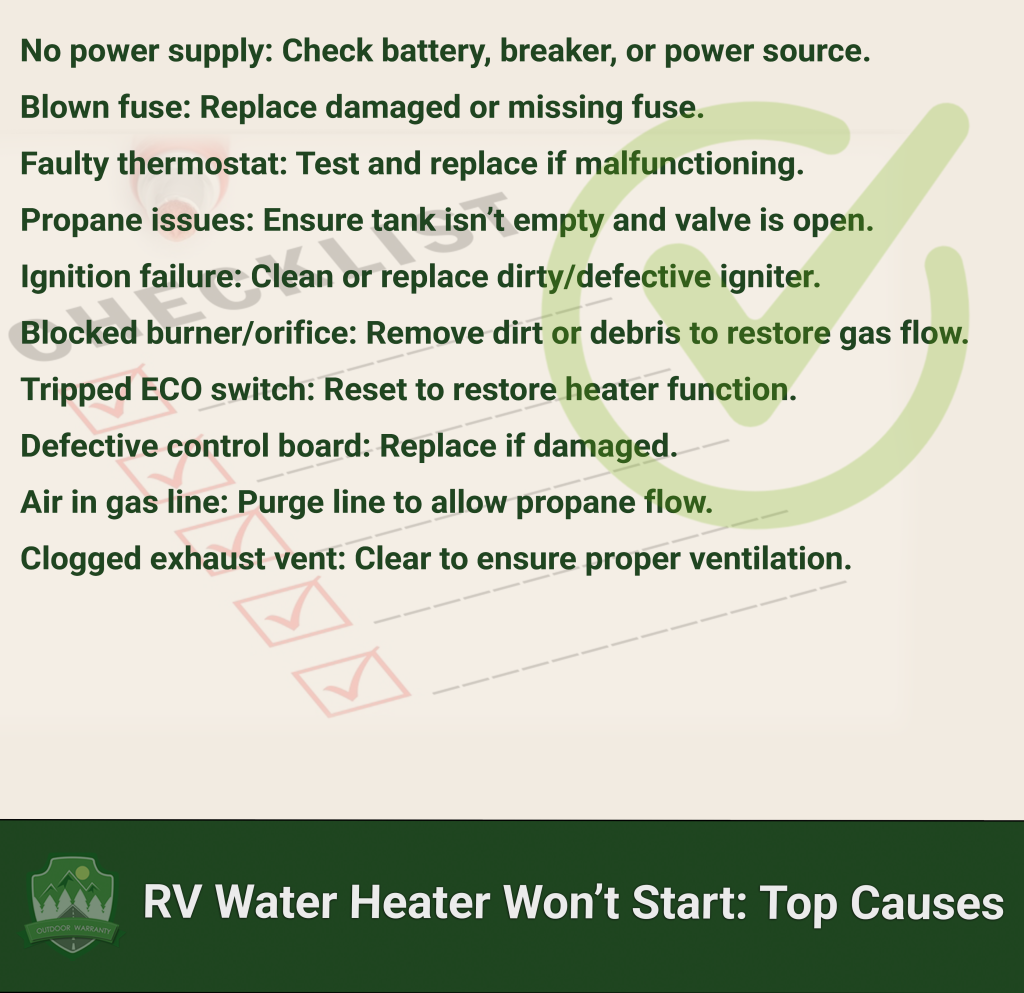
How do RV Water Heaters Work?
The RV water heater operates through a contained heating system with four essential components. The water heater includes a storage tank for holding water, an electrical heating element or gas burner for generating heat, a thermostat for monitoring temperature, and control panels for regulating operation. Electric models convert electrical energy directly into heat via the heating element, while gas-powered models burn propane to generate thermal energy that transfers to the water tank. Tank models store hot water in an insulated container, maintaining temperature until needed, while tankless designs heat water on demand without storage.
Water heaters activate when RV occupants turn on hot water fixtures, causing cold water to enter the system while warm water exits. The heating cycle begins automatically when the temperature drops below preset levels. The Recreational Motorhome water heaters operate on 120-volt electricity when connected to shore power or 12-volt DC power from batteries when boondocking. Gas variants light propane with an ignition system to heat the surrounding tank. Modern units feature safety mechanisms, including pressure-relief valves and automatic shutoffs to prevent overheating.
How to Reset My RV Hot Water Heater?
To reset your RV Hot Water Heater, follow the ten steps listed below.
- Turn Off the Power Supply. Locate the power switch or circuit breaker connected to the water heater. Switch off the power to prevent electrical issues. Wait 2 to 5 minutes to allow the system to reset.
- Shut Off the Propane Supply. Turn the propane valve to the off position. Ensure no gas is flowing before performing a reset. Leave the valve closed for 5 to 10 minutes to release pressure.
- Locate the Reset Button. Find the reset button on the control panel or near the thermostat. Look for a small button labeled “reset” or a similar marking. Check the user manual for the exact location if required.
- Press and Hold the Reset Button. Press the reset button firmly with a finger or a small tool. Hold the button for 10 to 30 seconds to allow the heater to reset. Release the button and wait a moment before proceeding.
- Turn the Power Supply Back On. Switch the power back on at the breaker or control panel. Ensure the heater receives electricity for proper operation. Observe the control panel for any error codes or warnings.
- Open the Propane Supply Valve. Slowly turn the propane valve back to the open position. Ensure gas flows appropriately to the heater. Listen for a faint hissing sound indicating gas movement.
- Test the Ignition System. Turn on the water heater and set it to the desired temperature. Listen to the sound of the ignition clicking and check for a flame. A functioning ignition system confirms that the heater is working.
- Check for Error Codes. Observe the control panel for flashing lights or error messages. Refer to the user manual to decode any error signals. Follow additional troubleshooting steps if errors appear.
- Inspect the Water Flow. Turn on a faucet to check if hot water is coming out. Allow the water to run for a few minutes to remove air from the system. Consistent hot water flow indicates a successful reset.
- Monitor Heater Performance. Let the heater run for a few minutes and check for regular operation. Listen for unusual noises or signs of malfunction. Ensure the heater maintains the set temperature without shutting off unexpectedly.

What Are the Common Troubleshooting Steps for an RV Water Heater Not Heating Water?
The common troubleshooting steps for an RV water heater that is not heating water are listed below.
- Check the Power Source: Verify if the water heater is connected to a working power source. Inspect the circuit breaker and reset it if it has tripped. Replace blown fuses to restore electrical power.
- Inspect the Propane Supply: Ensure the propane tank has enough fuel to operate the water heater. Open the gas valve completely to allow proper flow. Check for leaks using a soapy water solution and tighten connections if bubbles appear.
- Examine the Pilot Light: Look at the light to see if it burns. Relight it following the manufacturer’s instructions if it has gone out. Clean the thermocouple if the flame does not stay lit.
- Test the Heating Element: Use a multimeter to check if the heating element is functioning. Replace the element if it does not show continuity. Ensure all connections are secure before restoring power.
- Inspect the Thermostat: Adjust the thermostat to a higher setting to test its response. Replace the thermostat if it does not maintain the correct temperature. Ensure the sensor is in proper contact with the heating element.
- Flush the Water Tank: Drain the tank completely to remove sediment buildup. Refill it with fresh water to improve heating efficiency. Clean the tank regularly to prevent further blockages.
- Check for Blocked Burner or Orifice: Examine the burner and orifice for dirt or debris. Use compressed air or a brush to remove any obstructions. Ensure the burner produces a steady, blue flame.
- Inspect the Check Valve and Bypass: inspect if the valve is open to allow water flow. Verify that the bypass valve is in the correct position for heating. Replace faulty valves to restore proper operation.
- Test the Pressure Relief Valve: Lift the handle to see if water flows out. Replace the handle if it leaks or fails to release pressure. Ensure the valve is free from mineral buildup.
- Look for Wiring Issues: Inspect all wiring connections for loose or damaged wires. Tighten or replace connections as needed. Use a voltage tester to check for consistent electrical flow.
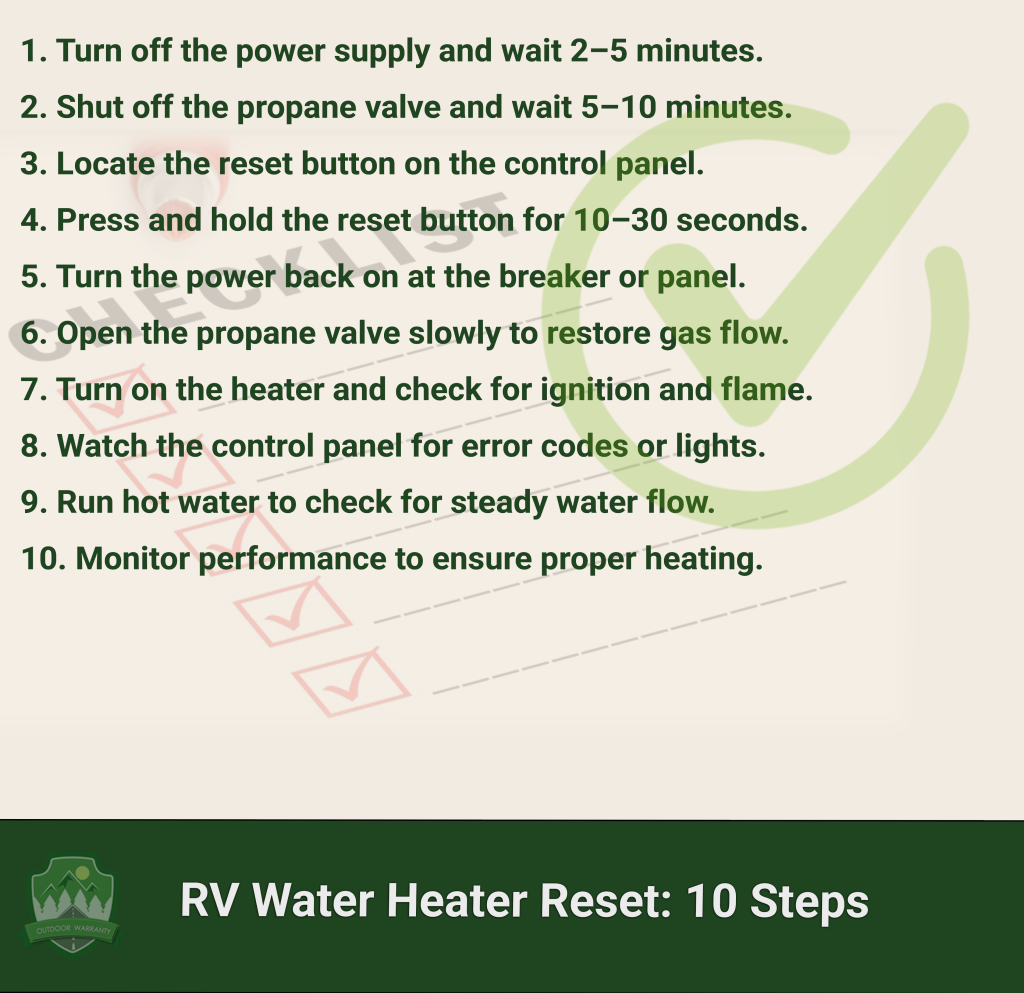
Why Is My RV Water Heater Only Producing Lukewarm Water?
Your RV Water Heater only produces lukewarm water because Sediment buildup inside the tank creates an insulating layer between heating elements and water, decreasing heat transfer efficiency. Faulty thermostats fail to signal proper heating temperatures, while damaged heating elements or gas burners deliver insufficient heat output.
Mixing valves malfunction by allowing excessive cold water into the hot water line, diluting the temperature. Smaller water heaters struggle to meet demand when multiple fixtures operate at once. Electrical problems contribute to lukewarm water issues in recreational vehicles. Low voltage from weak batteries or inadequate shore power connections prevents heating elements from reaching optimal temperatures.
Gas-powered units experience performance degradation from clogged burner tubes, faulty gas valves, or improper propane pressure. Water flow rates exceeding heater capacity force water through before adequate heating occurs. Professional inspection identifies specific causes through systematic troubleshooting of thermostat settings, heating elements, gas supply lines, sediment levels, and electrical connections to restore proper hot water function.

What Should I Check If My RV Water Heater Is Not Getting Power?
The things you should check if the RV Water Heater is not getting power are circuit breakers, fuses, power supply connections, on/off switches, and reset buttons. Circuit breakers trip due to power surges or electrical faults, while blown fuses interrupt current flow completely. Shore power connections must remain secure at campground pedestals and RV inlets.
Water heater power switches located on control panels require activation before operation begins. Problems frequently stem from thermal cut-off switches designed to prevent overheating component damage. Electrical wiring conditions play a role in water heater functionality, with loose, corroded, or damaged wires preventing proper current flow to heating elements. Voltage testing with multimeters verifies appropriate power levels reaching units, while control boards regulate all Electric water heater not working electrical functions within modern systems.
Ground Fault Circuit Interrupter (GFCI) outlets are installed for safety and shut down automatically when ground faults occur. Battery power levels below 12 volts prove insufficient for ignition systems, even when gas heating modes operate. Evaluation becomes required when basic troubleshooting fails to restore power, as internal component damage requires specialized repairs to prevent system deterioration or safety hazards.
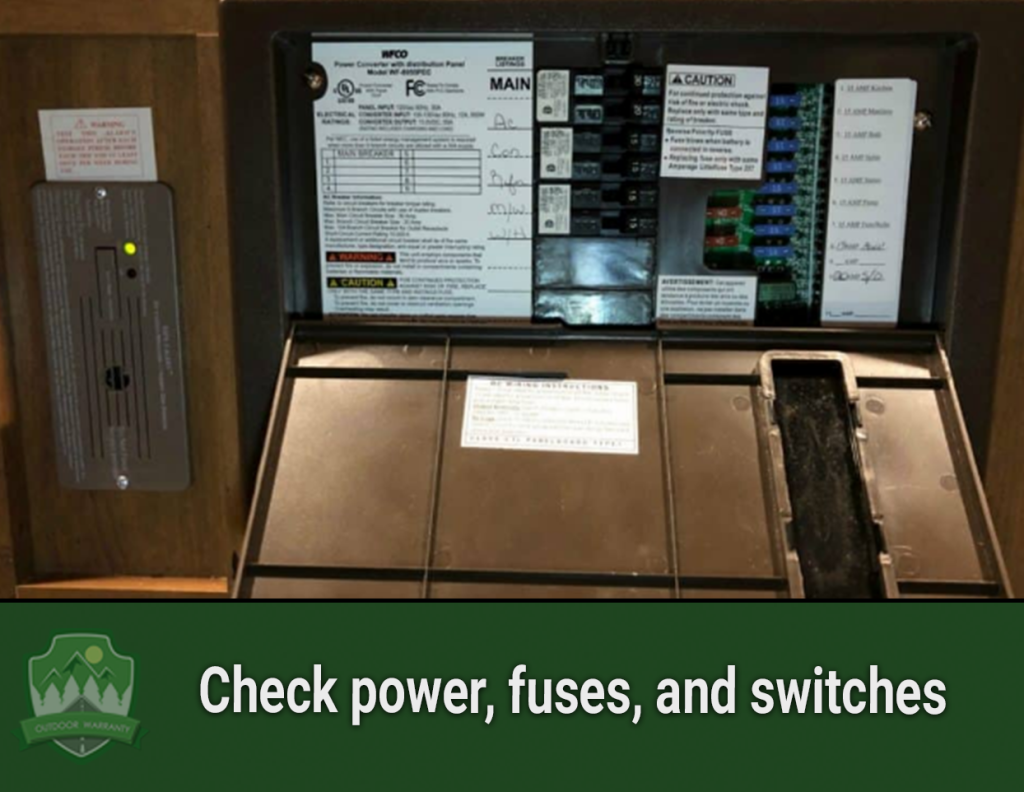
How can I Fix the RV Hot Water Heater Not Igniting?
You can fix the RV Hot Water Heater not igniting by checking propane supply levels and ensuring gas valves remain fully open. The ignition system requires cleaning to remove spider webs, debris, and carbon deposits, which block proper gas flow. Control boards must receive adequate 12-volt power from batteries or converters to operate ignition circuits. Igniter electrodes need adjustment to maintain proper spark gap, while gas pressure regulators require inspection for correct pressure settings. Thermocouple or thermopile components demand replacement when damaged because they are critical safety devices that verify flame presence before allowing continuous gas flow.
Propane-powered water heaters dominate the RV market because they heat water more rapidly than electric alternatives and operate effectively without shore power connections. The advantages include faster recovery times, the ability to function while boondocking, and dual-fuel capability when combined with electric elements.
Disadvantages involve more complex maintenance requirements, the potential for gas leaks, and dependency on propane availability. Modern Direct Spark Ignition (DSI) heaters replaced older pilot light systems with electronic ignition, which provides greater reliability in RV Problems (root-domain/rv/problem) situations but introduces additional electronic
Is It Safe to Reset My RV Water Heater?
Yes, it is safe to reset your RV water heater, but proper procedures have been followed. The reset process involves locating the reset button, the small red button near the thermostat, turning off power to the water heater, allowing it to cool for 10 to 15 minutes, pressing the reset button firmly until it clicks, and restoring power.
Safety precautions include shutting off electricity and gas supplies before attempting to reset, wearing protective gloves, ensuring the water heater has cooled adequately, and never bypassing safety devices. A professional inspection is required because it indicates a more serious underlying issue if the heater continues to trip after multiple resets.
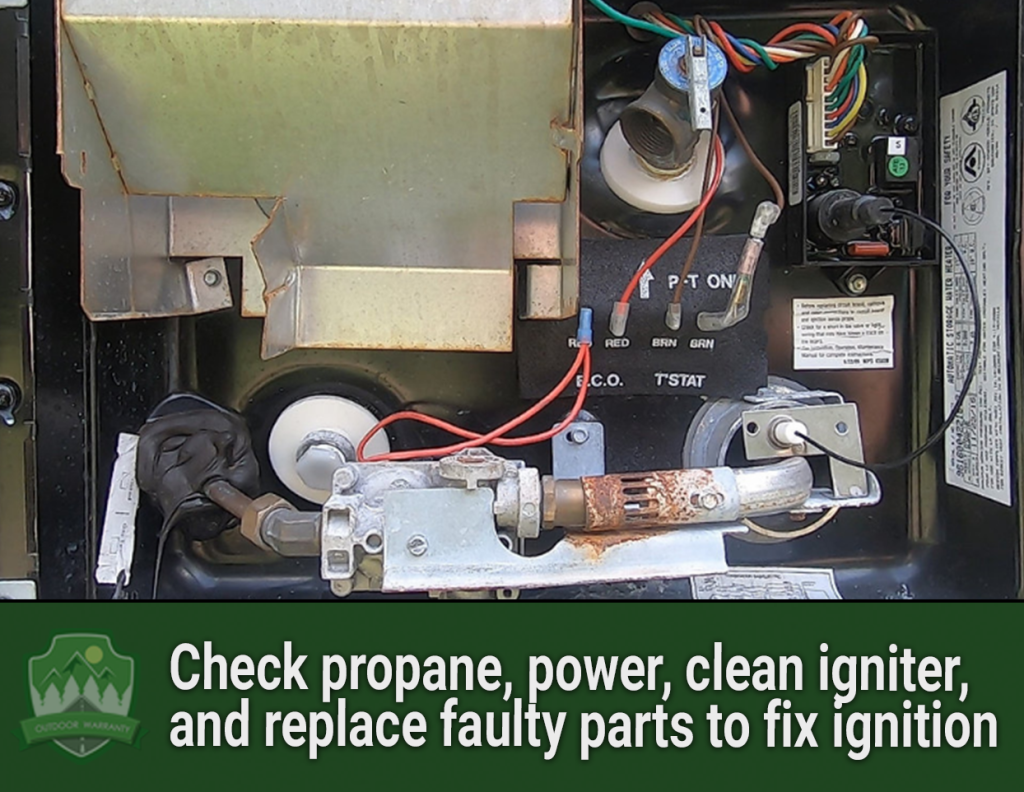
What Is the Best Way to Diagnose Electrical Issues in an RV Water Heater?
The best way to diagnose electrical issues in an RV water heater is through systematic testing with a multimeter to verify power at each connection point. Start by checking circuit breakers and fuses, then test for proper voltage at the power source, control board, and heating elements. Verify resistance readings across heating elements match manufacturer specifications, indicating replacements are needed.
Safety precautions demand disconnecting all power sources before testing, using insulated tools, working with dry hands on dry surfaces, and never bypassing safety devices. The Batteries for RV (root-domain/rv/how-long-battery-last) systems must maintain at least 12 volts for ignition systems to function correctly, testing battery voltage under load provides essential diagnostic information. Document all readings methodically and compare them to technical specifications before determining that professional repair is required for complex electrical problems.
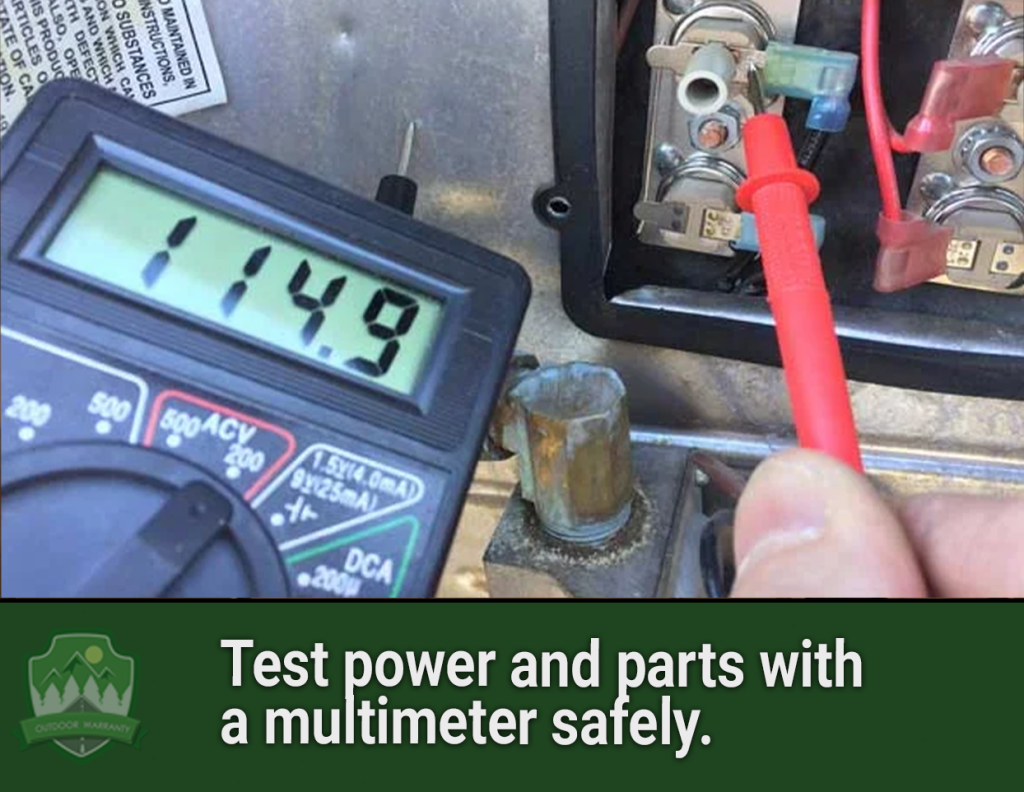
Why does My RV Water Heater Work on Gas but Not Electricity?
Your RV Water Heater works on gas but not electricity because of electrical failures. Common issues include a tripped circuit breaker, blown fuse, faulty electric heating element, damaged wiring connections, or defective thermostat. The water heater continues functioning normally even when electrical problems occur since the gas heating system operates independently of the electrical components.
The electrical heating element has burned out due to sediment buildup or age-related deterioration, preventing current flow while leaving gas operations unaffected. Dual-mode RV water heaters contain separate control systems for each power source, allowing one to operate while the other fails. Electric heating relies on 120-volt AC power from shore power connections or generators, which are unavailable or insufficient.
Thermal cutoff switches are designed to prevent overheating triggers prematurely, disabling only the electric function as a safety measure. Control boards in modern units occasionally develop electronic faults affecting just the electric heating circuit while maintaining gas functionality. Professional diagnosis becomes required when basic troubleshooting fails to resolve the isolated electrical system failure.

What are the Key Differences Between Troubleshooting a Gas and Electric RV Water Heater?
The key difference between troubleshooting a gas and electric RV water heater is that they focus on the heating mechanisms and safety systems. Gas water heaters require checking propane supply, valves, burner assembly cleanliness, ignition systems, and thermocouple functionality. Electric water heaters demand inspection of circuit breakers, voltage supply, heating element continuity, thermostat operation, and wiring connections.
Gas troubleshooting involves listening for ignition clicks, observing flame patterns, and detecting gas odors, while electric diagnosis relies on multimeter readings to verify electrical flow and resistance values. Safety concerns vary between the two systems, with gas troubleshooting focusing on preventing gas leaks, carbon monoxide hazards, and proper ventilation. Electric troubleshooting emphasizes avoiding electrical shock, ensuring proper grounding, and preventing short circuits.
Systems share common diagnostic areas, including water pressure issues, sediment buildup, and thermostat functionality. Gas systems require more frequent maintenance due to exposure to burning byproducts and fuel system components, while electric systems provide simpler operation but demand sufficient power supply to function correctly. Proper diagnosis tools differ, with gas analyzers needed for propane systems versus multimeters essential for electric component testing.
How can I Prevent Future Issues with My RV Water Heater?
The things you can do to prevent future issues with your RV Water Heater are listed below.
- Flush the Tank Regularly: Drain and flush the water tank every few months to remove sediment buildup. Use clean water to rinse out any remaining debris. Prevent blockages by keeping the tank free of mineral deposits.
- Inspect the Anode Rod: Check the anode rod for corrosion or heavy wear. Replace it when more than half of the rod has worn away. Protect the tank from rust by maintaining a functional anode rod.
- Clean the Burner and Orifice: Remove dust, dirt, or debris from the burner and orifice. Use a small brush or compressed air to clear any obstructions. Ensure the burner produces a steady blue flame for efficient heating.
- Check the Propane and Electrical Connections: Inspect propane lines and wires for cracks or loose connections. Regular maintenance for RVs (root-domain/rv/maintenance) helps prevent leaks and electrical failures. Secure all fittings to maintain proper operation.
- Test the Thermostat and Heating Element: Adjust the thermostat to verify it maintains the correct temperature. A multimeter is used to test the heating element for proper function. Replace faulty components to prevent inconsistent heating.
- Monitor the Pressure Relief Valve: Lift the valve handle occasionally to ensure it releases pressure properly. Replace the valve if it leaks or does not function correctly. Keep the valve clean to avoid blockages.
- Use a Water Heater Bypass in Storage: Turn on the bypass valve before storing the RV to prevent water from sitting inside the heater. Keep the system dry to reduce corrosion risks. Protect internal components by draining any leftover water.
- Protect Against Freezing: Empty the water heater before freezing temperatures arrive. Use RV antifreeze if storing the vehicle in cold weather. Prevent pipe damage by keeping the system dry in winter.
- Keep Vents and Airflow Clear: Remove obstructions from vents to allow proper airflow. Keep insects or debris from blocking ventilation areas. Ensure proper oxygen flow to maintain efficient heating.
- Schedule Professional Inspections: Have a technician inspect the water heater once a year. Identify and fix minor issues before they cause major problems. Extend the lifespan of the unit with regular checkups.
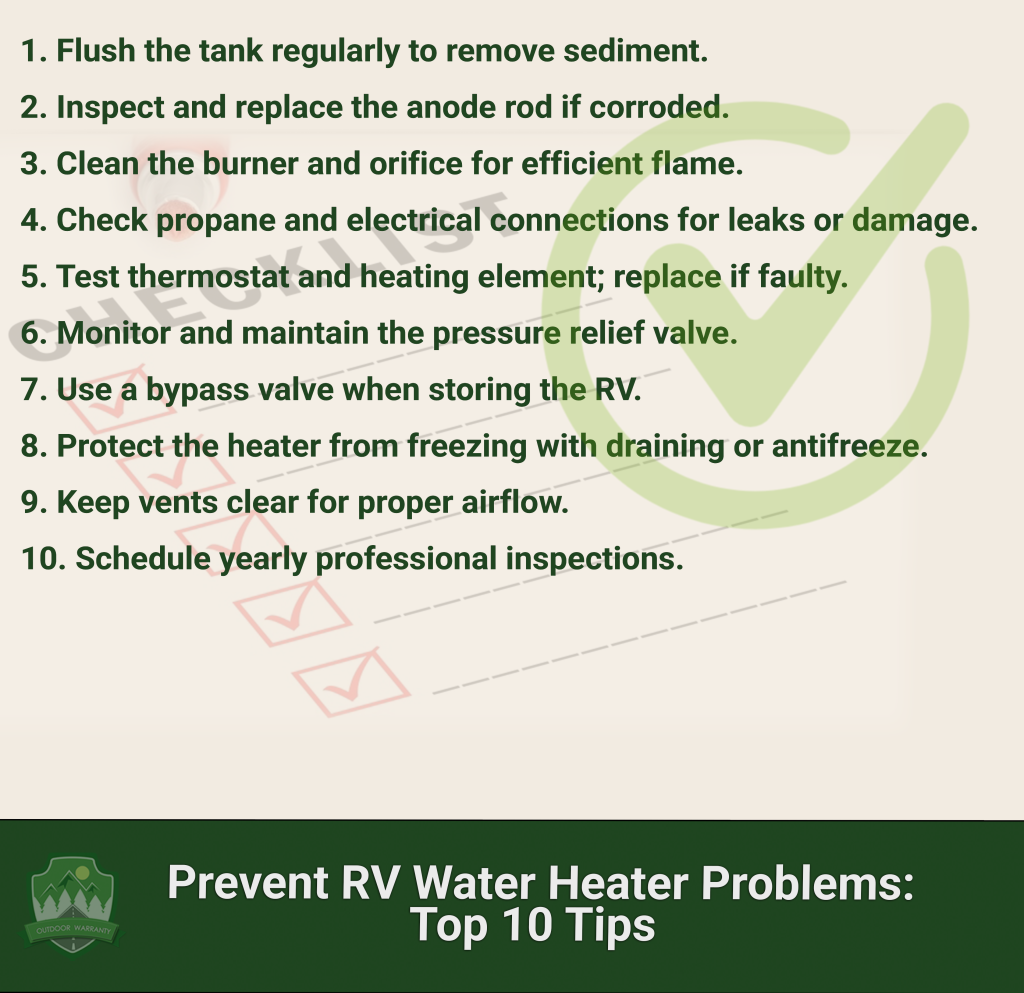
Should I Replace or Repair My RV Water Heater If It’s Not Working?
Yes, you should replace the RV water heater if it is not working and meets conditions that make replacement more economical than repair. Consider replacement if the unit is over 8 to 10 years old, has tank corrosion, leaks, or needs frequent repairs. Replace it if internal damage exceeds 50% of the replacement cost or an upgrade improves energy efficiency.
Repairs remain more cost-effective for minor issues like thermostat failure, heating element problems, ignition system malfunctions, or control board issues in newer units. Professional evaluation determines whether the situation warrants repair or replacement based on age, condition, repair history, and cost comparison. RV technicians recommend replacement when repair costs approach 50 to 70% of a new unit’s price.
Is the RV Water Heater covered by Extended Warranty?
Yes, the RV Water Heater is covered by Extended Warranty policies, but coverage specifics vary between providers and plan levels. Standard extended warranties cover mechanical and electrical failures caused by regular use or manufacturing defects. Covered components include heating elements, thermostats, control boards, gas valves, and ignition systems.
Policies exclude damage from neglect, improper maintenance, freezing, water quality issues, or modification. Coverage duration extends 1 to 7 years beyond the manufacturer warranty, with premium plans offering more comprehensive protection, including labor costs. The Extended Warranty for RVs (root-domain/rv/extended-warranty) coverage requires proof of proper maintenance and includes deductibles ranging from $50 to $200 per claim. Review policy documentation carefully, as covered components, claim processes, and transferability vary between warranty providers.